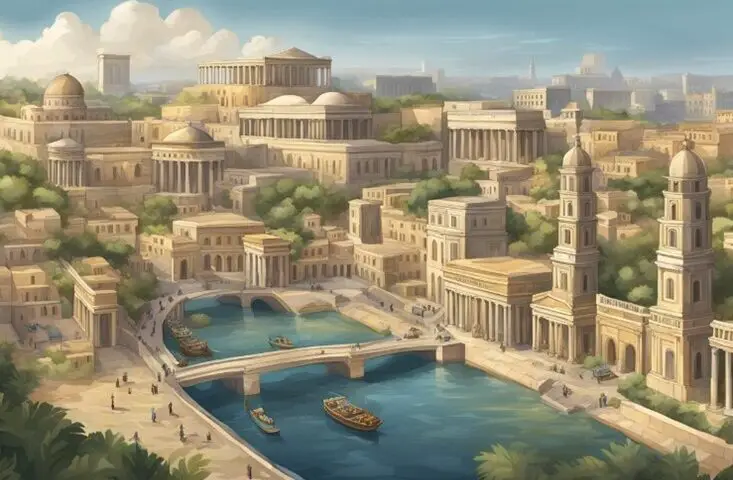|
Getting your Trinity Audio player ready...
|
Nestled along the Mediterranean coast of Egypt, lies the vibrant port city of Alexandria. Rich and bustling Alexandria history spans two millennia. Founded by Alexander the Great in 331 BC, the metropolis emerged as a hub of learning and culture.

It boasted the famous Library of Alexandria and the Pharos Lighthouse, one of the Seven Wonders of the Ancient World. And its strategic location made it a bustling seaport and a melting pot of diverse cultures and ideas.
Over many centuries, Alexandria played a crucial role in the ancient world. It became a central point for the development of the early Christian faith and was a beacon of Hellenistic civilisation.
The city’s streets echoed with the footsteps of scholars, traders, and revolutionaries, shaping it into a dynamic metropolis. The remnants of its past still stand as testaments to its long-lasting influence on history and society.
By the 20th and 21st centuries, Alexandria had evolved into a city that harmoniously blends its rich past with modern advancements.
Historical sites in and around the city draw international tourists who contribute to the city’s economy and cultural significance. Alexandria’s historical charm continues to captivate historians, archaeologists, and tourists alike, ensuring that its legacy remains alive and celebrated as one of the best historical cities.
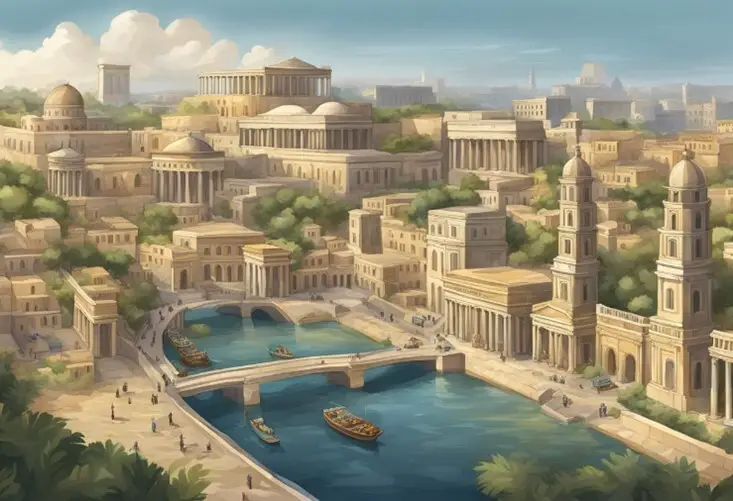
Key Takeaways
- Alexandria was founded by Alexander the Great in 331 BC.
- It was a significant cultural and commercial centre in the ancient world.
- Today, it blends historical heritage with modern advancements.
The Founding of Alexandria
Alexandria’s founding is deeply tied to Alexander the Great and its strategic position on the Mediterranean coast. These factors played a crucial role in its development and prominence.
Alexander the Great and the City’s Establishment

In 332 BCE, Alexander the Great, the famous Macedonian king, arrived in Egypt during his campaign to conquer the Persian Empire.
He envisioned a grand city that would serve as a hub of culture and trade. The location was chosen carefully, using the island of Pharos and the fishing village of Rhakotis as starting points.
Alexander’s plan was to create a Greek city that reflected Hellenistic ideals.
He commissioned architect Dinocrates to design the urban layout. Streets were arranged in a grid, a hallmark of Greek city planning, which emphasised order and functionality.
The establishment of Alexandria was both a statement of power and a practical move to strengthen his hold on the region.
The city quickly began to flourish under Ptolemaic rule after Alexander’s death. Its rapid development highlighted Alexander’s successful vision in creating a lasting centre of learning and commerce.
The City’s Location and Strategic Importance
Alexandria’s location at the mouth of the Nile gave it significant advantages. The city served as a maritime hub connecting the Mediterranean with the Asian and African trade routes. And its strategic position enabled Alexandria to thrive economically and culturally.
The natural harbour provided by the island of Pharos further enhanced its importance. While the famous Lighthouse of Alexandria, or Pharos Lighthouse, marked the harbour becoming one of the Seven Wonders of the Ancient World.
The lighthouse not only guided sailors to safety but also symbolised the city’s prominence.
Additionally, the city’s placement facilitated military strategy. It acted as a fortified base protecting Egypt’s northern coastline. And the defences ensured Alexander’s empire had a strong foothold in both the Mediterranean and the broader region.
Alexandria History in the Ancient World
In the ancient world, Alexandria was not just a prominent city; it was a hub of trade, culture, and intellect. Its strategic position along the Nile and the Mediterranean Sea enhanced its significance.
A Major Centre of Christianity in the Eastern Roman Empire
St. Mark was the founder of the See in a major centre of Christianity in the Eastern Roman Empire. Alexandria remains the seat of the Orthodox Patriarchate of Alexandria.
The city fostered a renowned theological school and was home to influential Church Fathers, blending Christian faith with Hellenic culture. Both Greek Orthodox and Coptic Churches claim this rich heritage.
After the Arab conquest in 641 CE, Alexandria’s prominence declined. Today, the Greek Orthodox Patriarchate of Alexandria and all Africa, led by Patriarch Theodore II, focuses on missionary work across the continent.
Reflections on the City of Alexandria and the growth of the early Christian faith explores Alexandria’s Christian history, drawing from primary and secondary sources including academic articles, books, Biblical and Church documents, and electronic resources. It highlights the city’s enduring significance in the development and spread of Christianity, particularly in Africa.
Alexandria as a Centre of Knowledge
Ancient Alexandria stood out as a leading centre of knowledge, and it flourished as a hub where scholars from across the Mediterranean gathered. Contributions in science, medicine, and philosophy were remarkable.
The Museum of Alexandria fostered intellectual collaboration. Here, scholars held debates and engaged in research, creating a thriving atmosphere for discovery.
The blend of different cultures and ideas made Alexandria a melting pot of ancient wisdom and innovation.
The Lighthouse of Alexandria
The Lighthouse of Alexandria, also known as Pharos, was one of the Seven Wonders of the Ancient World. Built on the small island of Pharos by the entrance to Alexandria’s harbour, it safely guided sailors to the bustling port.
The lighthouse, constructed during the reign of Ptolemy II Philadelphus, stood approximately 100 metres tall. It featured three tiers: a square base, a cylindrical centre, and a smaller circular section at the top, where a fire burned constantly.
The feat of engineering signified Alexandria’s importance as a maritime hub.
The Renowned Library of Alexandria
The Library of Alexandria was arguably the most famous intellectual site in the ancient world. Founded under the Ptolemaic dynasty, it aimed to gather all the world’s knowledge. Apart from countless scrolls covering science, literature, and philosophy, the library collected works from different civilisations, making it a comprehensive repository.
It also attracted scholars, including Euclid and Archimedes, who made substantial contributions to their fields. Though it was eventually destroyed, its legacy as a beacon of learning and culture is remembered to this day.
Cultural and Political Evolution
During its long history, Alexandria has experienced significant cultural and political changes. This section explores its cosmopolitan life, Roman rule, and eventual decline.
Cosmopolitan Life in Alexandria

Alexandria was a vibrant melting pot of cultures and ethnicities, and it became a hub of commerce, education, and philosophy.
The city featured a Greek polis design, incorporating Greek customs while welcoming indigenous Egyptians and other peoples from the Mediterranean. The Library of Alexandria, once the largest in the world, attracted scholars from far and wide. And its intellectual environment encouraged knowledge exchange.
Alexandria’s cosmopolitan makeup significantly enriched its cultural and intellectual landscape.
Alexandria under Roman Rule
In 30 BCE, Alexandria came under Roman control after they defeated Antony and Cleopatra. The city continued to thrive as a major trade centre, connecting Rome with the Middle East and Asia.
Under Roman rule, Alexandria maintained much of its Greek cultural flair but also incorporated Roman administrative systems. The Roman influence brought economic stability and urban development. And the city became an early centre for Christianity.
By the 3rd century, it was a significant location for Christian theologians and philosophers. Origen (c. 184-253 CE) Christian scholar and theologian and the Bishop of Alexandria, Athanasius (c. 296-373 CE) were instrumental in shaping Christian doctrine. Constantine’s conversion bolstered Christianity’s presence in Alexandria, furthering its political and religious significance.
The Decline of Alexandria
The decline of Alexandria started in the late Roman period and continued into the 7th century.
Several factors contributed to this downturn:
- Continuous conflicts – including fleeting control and periodic invasions, weakened the city’s defences and stability.
- Economic shifts – also played a part. Trade routes changed, reducing Alexandria’s role as a central trading hub, and
- Administrative changes – under Byzantine rule led to neglect and decline in public infrastructure.
By the 7th century, with the Arab conquest, Alexandria had notably diminished in prominence, marking the end of an era as a leading cultural and political centre.
Alexandria from the Medieval to the Modern Era
Alexandria’s journey from the medieval period into modern times is marked by changes in governance, infrastructure, and strategic importance. The city saw a shift under Islamic rule and again with European intervention and the French invasion.
Islamic Conquest and Alexandria
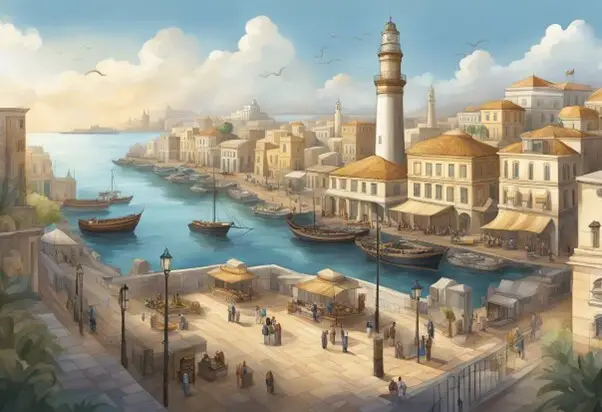
In 642 AD, Alexandria was captured by Muslim forces led by General Amr ibn al-As. This conquest marked the end of Byzantine rule in Egypt and the start of Islamic governance.
Under Muslim rule, Alexandria thrived as a port city, facilitating trade between the Mediterranean and the Red Sea regions. The city’s economy flourished due to its strategic position and access to trade routes.
Alexandria’s existing infrastructure was maintained and expanded, making it a vibrant hub for merchants and scholars. And the city experienced cultural growth, becoming a centre for learning with contributions to science, literature, and arts.
European Interest and the French Invasion
Interest in Alexandria grew among European powers during the late 18th century. In 1798, Napoleon Bonaparte invaded Egypt as part of his campaign to weaken British influence in the region. The capture of Alexandria was a key moment in this campaign.
Napoleon’s forces aimed to strengthen their control over the Mediterranean by using the city’s strategic ports. And French occupation led to the introduction of modern innovations and changes in governance.
Even after the French left, European influence remained, shaping Alexandria’s urban and cultural development. European interest and the French invasion had long-lasting effects on Alexandria, affecting its role in global trade and politics. The city’s accessibility to both the Mediterranean and the Red Sea continued to enhance its strategic importance.
Archaeological Relevance and Discoveries
Alexandria’s rich archaeological history offers insights into ancient civilisations and their cultures.
Excavations have unearthed significant artefacts and structures, shedding light on Alexandria’s past and how it has influenced our history.
Archaeological Influence: Understanding the Past
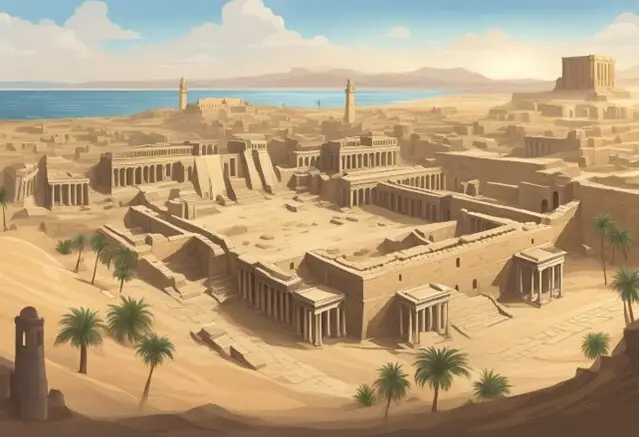
Studies of ancient Alexandria have impacted the understanding of the city’s historical and cultural development. The archaeological findings support the city’s description as a cosmopolitan hub in historical texts.
Early research initiatives laid the groundwork for modern excavations, revealing the scope of Alexandria’s influence in trade, politics, and culture.
Excavations and Insights into Ancient Alexandria
Excavations in Alexandria have provided significant insights into its history, culture, and urban development.
Key Excavations and Findings:
- Underwater Archaeology:
- Pharos Lighthouse: One of the Seven Wonders of the Ancient World, remains of the Pharos Lighthouse were found submerged in Alexandria’s Eastern Harbour. Divers discovered large stone blocks and statues that likely were part of the lighthouse.
- Royal Quarters: The submerged royal quarters in the harbour, including palaces and temples, have been explored, revealing the grandeur of Ptolemaic Alexandria.
- Kom el-Dikka:
- Discovered in the 1960s, this site includes a large Roman theatre, baths, lecture halls (auditoria), and residential areas, providing a glimpse into the urban life of late Roman and early Byzantine Alexandria.
- The site has revealed mosaics and other artifacts that highlight the city’s artistic and cultural richness.
- Catacombs of Kom el-Shoqafa:
- The extensive necropolis, discovered accidentally in 1900, dates back to the 2nd century CE and combines Egyptian, Greek, and Roman architectural elements.
- The catacombs include many burial chambers, a triclinium for funerary banquets, and intricately decorated tombs.
- Serapeum of Alexandria:
- Excavations have unearthed parts of the Serapeum, a temple dedicated to the Greco-Egyptian deity Serapis. This site included the famous Library of Alexandria.
- Archaeologists have found statues, inscriptions, and architectural remains that shed light on the religious practices and scholarly activities in ancient Alexandria.
- Pompey’s Pillar:
- This Roman triumphal column is one of the few ancient structures still standing. Surrounding excavations have revealed the remains of a Serapeum and other related buildings.
Historical Insights:
- Urban Layout: Excavations have helped reconstruct the city’s urban layout, with a central grid pattern typical of Hellenistic cities. It includes broad streets, public buildings, and residential areas.
- Cultural Synthesis: The blend of Egyptian, Greek, and Roman elements in architecture and art found in excavations illustrates the cultural synthesis that characterised Alexandria.
- Economic Hub: Artifacts such as pottery, coins, and trade goods highlight Alexandria’s role as a major commercial hub in the Mediterranean.
- Scholarly Activity: Findings related to the Library of Alexandria and various educational institutions underscore the city’s reputation as a centre of learning and intellectual activity.
Challenges:
- Modern Urbanisation: Much of ancient Alexandria lies beneath the modern city, making large-scale excavations difficult.
- Submersion: Parts of the ancient city are submerged, and underwater archaeological techniques are needed to fully explore it.
The excavations have significantly enhanced our understanding of Alexandria’s historical significance, urban development, and cultural impact.
The Seaport – Trade History and Development
The Alexandria seaport, located on the Mediterranean coast of Egypt, has played a pivotal role in trade and development over millennia. It is mainly due to the city’s strategic location and the construction of the Great Harbour, that it was originally a hub for trade between Europe, Africa, and Asia.

It thrived under the Ptolemaic dynasty, facilitating the exchange of grain, papyrus, textiles, and spices. During the Roman era, Alexandria’s port continued to flourish as a vital link in the trade networks of the Mediterranean and the Indian Ocean. However, the city’s prominence waned after the decline of the Roman Empire and the Muslim conquest in the 7th century, when trade routes shifted towards the Persian Gulf.
In the medieval period, Alexandria experienced a resurgence under the Mamluks and later the Ottomans, serving as a key point for pilgrims and merchants. The construction of the Mahmoudiyah Canal in the 19th century by Muhammad Ali Pasha revitalised the port, linking it to the Nile and boosting trade.
The modern development of Alexandria’s seaport began in earnest in the late 19th and early 20th centuries, with the expansion of port facilities to accommodate increasing maritime traffic. The construction of docks, warehouses, and the introduction of modern technologies transformed Alexandria into one of the most important ports in the Mediterranean.
Today, the seaport remains a vital commercial hub, handling a substantial portion of Egypt’s imports and exports. It has modernised continuously to meet global shipping standards, ensuring its position as a key player in international trade and a cornerstone of Egypt’s economy.
21st Century Alexandria
Alexandria in the 21st century balances preserving its rich heritage with embracing modern growth. This includes the conservation of its historic sites and the development of a modern city identity.
21st Century Conservation of the City’s Historic Sites
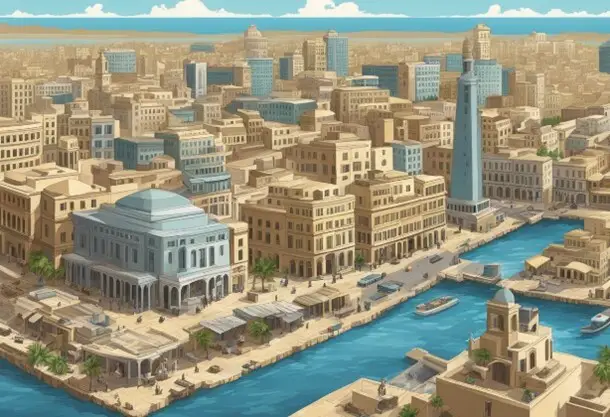
In the 21st century, Egypt has undertaken several initiatives to conserve Alexandria’s historic sites. These efforts involve a combination of government action, international collaboration, and modern technology to preserve and protect the city’s rich archaeological heritage.
Key Conservation Efforts:
- Government and Institutional Initiatives:
- Supreme Council of Antiquities (SCA): The SCA oversees conservation projects and coordinates efforts to protect and restore archaeological sites in Alexandria.
- Bibliotheca Alexandrina: The modern library and cultural centre, built near the ancient site of the Library of Alexandria, plays a significant role in promoting heritage preservation through research, exhibitions, and educational programmes.
- International Collaborations:
- UNESCO: Alexandria is part of UNESCO’s World Heritage Tentative List, and the organisation supports projects and provides expertise.
- European Union and Other Foreign Agencies: These entities fund and collaborate on archaeological and conservation projects, offering technical support and training for local conservators.
- Underwater Archaeology:
- European Institute for Underwater Archaeology (IEASM): Led by Franck Goddio, the IEASM has conducted significant underwater excavations in Alexandria’s Eastern Harbour, including the discovery and preservation of artifacts from the submerged royal quarters and the Pharos Lighthouse.
- Modern Technology: The use of sonar mapping, 3D modeling, and remote-operated vehicles (ROVs) has enhanced the ability to locate, document, and preserve submerged archaeological sites.
- Restoration Projects:
- Kom el-Dikka: Continuous restoration and conservation efforts at the Kom el-Dikka site, including the Roman theatre, baths, and auditoria, ensure the preservation of these structures and enhance their accessibility to the public.
- Catacombs of Kom el-Shoqafa: Restoration work focuses on stabilising the structure, preserving wall paintings, and improving the site for visitors.
- Education and Public Engagement:
- Training Programs: Workshops and training programs for Egyptian archaeologists and conservators, often in collaboration with international experts, enhance local capacity for heritage preservation.
- Public Awareness Campaigns: Efforts to raise awareness among the local population and tourists about the importance of preserving Alexandria’s heritage through media campaigns, educational programs, and community involvement.
- Technological Integration:
- Digital Documentation: Comprehensive digital documentation of artifacts and sites using 3D scanning and photogrammetry helps create detailed records that aid in conservation and virtual reconstruction.
- Virtual Reality (VR) and Augmented Reality (AR): These technologies are used to create immersive experiences for visitors, allowing them to explore reconstructed ancient sites while minimising physical impact on the actual locations.
Challenges and Future Directions:
- Urban Encroachment: Modern development poses a threat to many historic sites, as Urban growth has to be balanced with heritage conservation.
- Funding and Resources: Sustaining long-term conservation projects requires substantial financial investment and resources, which can be difficult to secure.
- Climate Change: Rising sea levels and environmental changes threaten coastal and submerged sites, necessitating innovative conservation approaches.
The combined efforts aim to protect and conserve Alexandria’s historic sites, ensuring that future generations can appreciate and learn from the city’s cultural heritage.
Alexandria’s 21st Century Identity
Alexandria, Egypt, has evolved significantly in the 21st century, blending heritage with modern development to position itself as a contemporary urban centre. Several factors contribute to its identity and how it stacks up as a modern city today.
Home to approximately 5.5 million people, the figure reflects the city’s status as the second-largest city in Egypt. Second to Cairo (20 million) it is a major urban centre in the Mediterranean region.
Modern Development and Infrastructure
- Urban Expansion:
- Alexandria’s growing infrastructure includes residential areas, commercial complexes, and transportation networks. The expansion has aimed to accommodate a growing population and economic activities.
- Transportation:
- The city has improved the transportation infrastructure with projects like the Alexandria Metro, an expanding tram network, and enhanced roadways to reduce traffic congestion and improve connectivity within the city and with other regions.
- Port of Alexandria:
- As one of the largest ports in the Mediterranean, the Port of Alexandria plays a crucial role in the city’s economy. It facilitates international trade and boosts local industries. Modernisation has enhanced capacity and efficiency.
- Technology and Innovation:
- Alexandria embraces modern technology through initiatives such as smart city projects, increased internet connectivity, and tech hubs that foster innovation and entrepreneurship.
Economic and Cultural Aspects
- Economy:
- The city’s economy is diverse, encompassing shipping, manufacturing, tourism, and services. The presence of several universities and research institutions also contributes to its economic dynamism.
- Tourism:
- Alexandria is a major tourist destination, attracting visitors to its historic sites, beaches, and cultural landmarks like the Bibliotheca Alexandrina.
- Education and Research:
- Alexandria University and the Bibliotheca Alexandrina play a pivotal role in education and research, fostering a culture of learning and intellectual growth.
Cultural Identity
- Heritage Preservation:
- The city’s identity is deeply rooted in its historical and cultural heritage. Conservation efforts and the promotion of archaeological sites and museums help the connection to the past.
- Multicultural Influence:
- Alexandria has been a melting pot of cultures, and its multicultural legacy continues to influence a modern identity. The city’s diverse population includes Egyptians, Greeks, Italians, and other communities who contribute to the culture.
- Arts and Literature:
- Alexandria’s vibrant arts scene has numerous galleries, theatres, and cultural events that reflect its artistic heritage. The city has been an inspiration for numerous literary works and continues to be a hub for writers and artists.
Social and Environmental Challenges
- Urbanisation:
- Rapid urbanisation poses challenges such as housing shortages, traffic congestion, and strain on public services. Addressing these issues requires sustainable urban planning and development strategies.
- Environmental Concerns:
- Coastal erosion, pollution, and the impact of climate change are significant environmental concerns. Efforts to mitigate these issues include initiatives for sustainable development and environmental conservation.
Prospects
- Sustainable Development:
- Alexandria focuses on sustainable development practices to balance economic growth with environmental preservation and social well-being.
- Cultural Revival:
- Investment in cultural projects, such as the restoration of historic sites and the promotion of cultural events, help preserve Alexandria’s unique identity while attracting tourists and fostering local pride.
- Technological Advancements:
- Embracing technology and innovation is crucial for Alexandria’s future, enhancing its competitiveness and improving the quality of life for residents.
Alexandria’s 21st Century identity is defined by its historical legacy, cultural diversity, and ongoing modernisation. While it faces challenges typical of rapidly growing urban centres, its strategic initiatives in infrastructure, economic development, and cultural preservation position it as a significant and dynamic city in the 21st century.
Local Culture and Society
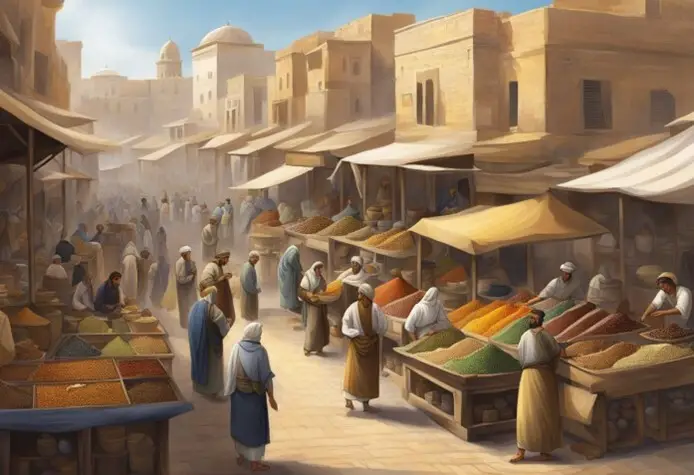
Alexandria’s local culture is rich and diverse, deeply rooted in its historic past and the vibrant community that lives there today. This culture is especially visible in Old Town Alexandria, a charming area with a rich heritage.
Influence and Legacy
A beacon of culture, knowledge, and power, Alexandria’s impact extended deeply into literature, history, and modern mystique.
Literature and History
Alexandria’s rich and varied history marked its role as a centre for learning and culture. The Great Library of Alexandria houses thousands of scrolls and works from across the world. And ancient accounts praise it for its vast repository of knowledge.
In the realm of politics and drama, the figure of Mark Antony played a significant role. Antony’s liaison with Cleopatra and their association with Alexandria became legendary, etched into literature and historical accounts. They symbolised political alliances and romantic sagas that fascinate today’s historians and writers.
The Enduring Mystique of Alexandria
The allure of Alexandria came not just from its historical significance but also from its cultural diversity. The city’s cosmopolitan nature made it a melting pot of cultures and differing ideas.
Even after the decline of the city, Alexandria’s legacy remained strong. Its reputation as a hub of learning and culture persisted, influencing new generations.
Literature, films, and historical studies still explore and reimagine the city’s awe-inspiring past.
The enduring mystique can also be seen in how modern cities are often compared to ancient Alexandria. The mystique began early and continues today, proving that its influence is far-reaching and timeless.
Final Thoughts
The connection between Alexandria, Egypt and Alexandria, Virginia, USA, though not a direct historical or geographical link, lies in the origin of the name.
Alexandria, Virginia named after Alexandria, Egypt, was a deliberate homage to the ancient Egyptian city.
The town in Virginia, named by John Alexander, a prominent landowner in the area, was established in 1749. The choice of name was likely influenced by:
- The historical significance of Alexandria in Egypt as a centre of learning and culture in the ancient world.
- The trend of naming new settlements in colonial America after famous historical or classical places.
- The similarity in geographical location – both cities are port cities situated near major rivers, (the Nile and the Potomac).
While there’s no direct connection in terms of shared history or population, the naming reflects the cultural and intellectual aspirations of the American colonists, who often looked to classical antiquity for inspiration.
There are many Alexandrias around the world. And many of them were also named in honour of the original Egyptian city or Alexander the Great himself.
Why not Join Us
If you enjoyed this article, we would like to offer you two gifts – our Starter Pack of 4 James King’s books and our Weekly Digest, which you can receive by email.

